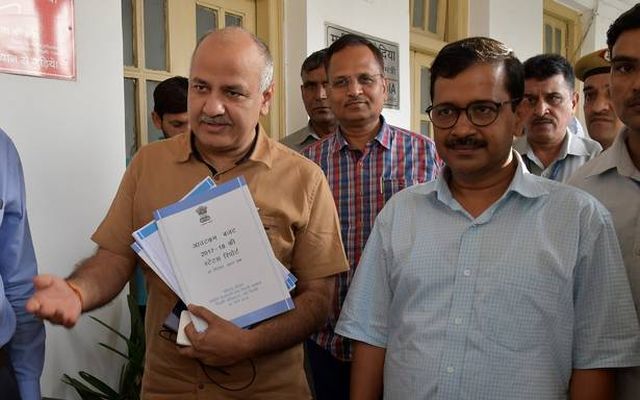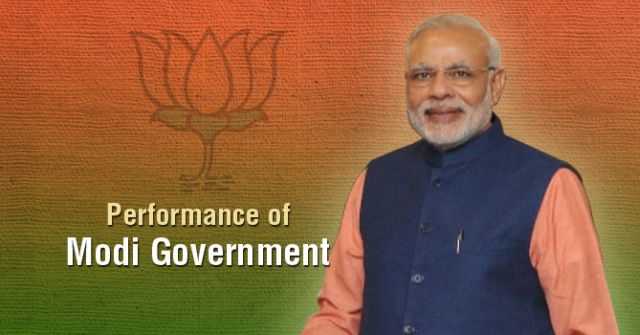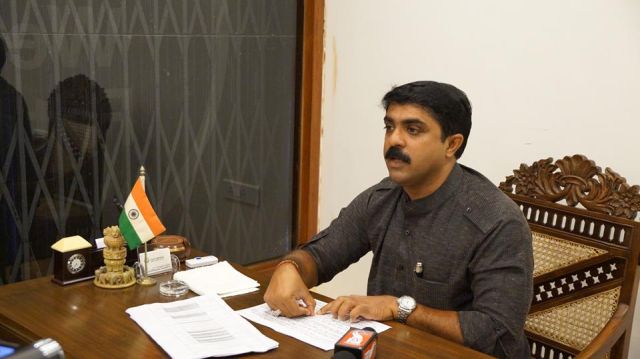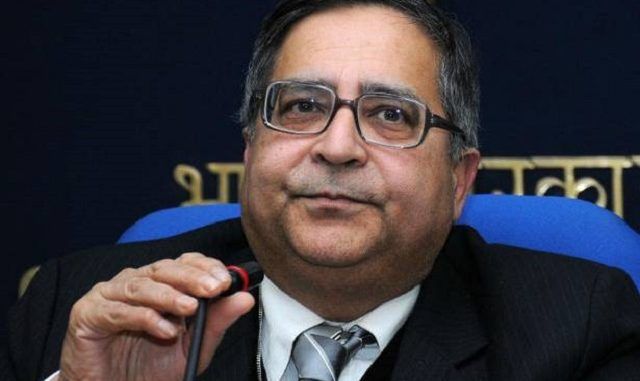
by Editor | May 25, 2021 | News, Politics

H.D. Kumaraswamy
Bengaluru : Settling speculation over the nature of the state budget for fiscal 2018-19, Karnataka Chief Minister H.D. Kumaraswamy has said that he will present a full budget in July.
“I will present a full budget in July first week,” Kumaraswamy told reporters on Tuesday at the Press Club in his maiden press conference after assuming office on May 23.
He said Congress President Rahul Gandhi had agreed to his proposal for a full-fledged budget with suggestions from the two allies.
“When I discussed the issue with Gandhi in New Delhi, he asked me to go ahead with a full budget and not to worry about what others may say,” Kumaraswamy said.
His clarification came two days after former Congress Chief Minister Siddaramaiah told the media that Kumaraswamy need not present a full budget as he had already presented a budget for the fiscal in February ahead of the May 12 Assembly election.
Downplaying Siddaramaiah’s statement, Kumaraswamy said a new government had every right to present its own budget based on its poll manifesto and in the interests of the people.
“Though our party (JD-S) did not get majority to implement our poll manifesto, especially farm loans, we are committed to fulfilling as many needs of the people, especially farmers, the poor, downtrodden and women,” he said.
The coordination committee of the alliance partners has decided to draft a common minimum programme containing promises they made to the people prior to the election.
As the Congress had agreed to support the Janata Dal-Secular in forming the third coalition government in the state over a decade later, the Chief Minister said he was not only committed to continue many of the social welfare schemes of the previous government but also flag new programmes that were common to both the parties.
Meanwhile, a JD-S leader told IANS that “every newly elected government is entitled to present its own budget at the state and central level in a democratic set-up like ours to reflect the aspirations and expectations of the people across the state or country”.
The Chief Minister also got Gandhi’s approval to waive loans of farmers with interest that were borrowed from state cooperative banks, rural, regional and state-run banks.
“The Chief Minister plans to announce the waiver as part of the budget proposals in the monsoon session of the Assembly next month,” added the leader.
—IANS

by Editor | May 25, 2021 | Corporate, Corporate Governance, Economy, Finance, News, Politics
 New Delhi : The Delhi Assembly on Tuesday passed the Rs 53,000 crore “green” Budget for 2018-19, with the maximum share for education and health in allocations and a focus on fighting pollution, including commissioning of 1,000 electric buses and subsidies for switching to non-polluting fuel.
New Delhi : The Delhi Assembly on Tuesday passed the Rs 53,000 crore “green” Budget for 2018-19, with the maximum share for education and health in allocations and a focus on fighting pollution, including commissioning of 1,000 electric buses and subsidies for switching to non-polluting fuel.
Of the total budgetary allocations, up from Rs 48,000 crore in 2017-18, as much as Rs 13,997 crore (26 per cent of the Budget) has been allocated to the education sector and Rs 6,729 (12.7 per cent) to the health sector.
The government also gave Rs 6,903 crore to the local bodies, which is 13 per cent of the total Budget and is 9.88 per cent higher over the 2017-18 allocations.
The 26 anti-pollution programmes, spanning four departments — Environment, Transport, Power, and Public Works — include a real-time, round-the-year study in partnership with the University of Washington to understand sources of pollution.
Others include replacing all street lights on PWD roads with energy efficient LED lights, an extensive tree plantation drive, and new city forests in Jaunapur, Ayanagar, Dera Mandi and Bela Farm among others.
The programmes also have a slew of incentives for switching to non-polluting fuel, including 50 per cent concession in registration charges for private cars with factory-fitted CNG kits.
Restaurants will be given a subsidy of Rs 5,000 per ‘tandoor’ or earthen oven to replace coal-based ones with electricity or gas-based variants.
A subsidy of up to Rs 1 lakh will be given to industries in approved industrial areas, to switch to piped natural gas from existing polluting fuels.
Establishments would get a subsidy of up to Rs 30,000 to switch from diesel generator sets to electricity generator sets.
The government will also launch an incentivised pilot agriculture-cum-solar farm scheme, under which solar panels will be installed on raised structures on agricultural farms without affecting the normal farming activities.
Another pilot project aims to install solar panels over 16 km length of cycle tracks.
The Rs 13,997 crore allocated for the education sector was up from Rs 3,525 crore in the previous budget and Finance Minister Sisodia said that education has been getting about 25 per cent of the total Budget for the third consecutive year.
A sum of Rs 175 crore was allotted for installing 1.2 lakh closed-circuit televisions in all government schools, which would enable parents to view online their children’s activities in the classroom.
The Rs 6,729 crore for health, up from Rs 2,627 crore in the previous budget, has Rs 403 crore allocated for Mohalla Clinics and Polyclinics and Rs 15 crore for setting up mobile van clinics.
Others important allocations include Rs 100 crore for free Wi-Fi, a project launched on a pilot basis in 2016 but which failed to take off.
Also, Rs 1,500 crore has been allocated for infrastructure development of unauthorised colonies across the city and Rs 10 crore has been earmarked for starting self-defence classes for girl students of government schools.
—IANS

by Editor | May 25, 2021 | Opinions
 By Amit Kapoor,
By Amit Kapoor,
Unlike most countries, the budget is usually an eventful affair in India and is a heated topic of national conversation around the time of its release. The underlying national interest behind it is mostly because the budget holds something for everyone — ranging from a small farmer to a big industrialist. However, from this year onwards, much of its sheen will be off by a bit.
The tinkering of indirect taxes, which was an aspect of the budget that affected everyone in all corners of the country, is not within the Centre’s domain anymore. Since the implementation of the Goods and Services Tax (GST), all indirect taxes — except for customs duty — have to be decided upon by the GST Council instead of being annually altered based on short-term political interests. Therefore, the first budget after the GST reform will be a challenging one for the government.
The fact that this will be the last full budget before the 2019 elections and that the government has already spent all of its budgeted expenditure for this financial year will further complicate matters. The oncoming elections affects the budget in multiple ways.
First, if the Gujarat election results are to be taken as indicative of the national sentiment, the BJP government is more popular in urban areas than it is in the countryside. The recently released CSO growth estimates show why. The farm and allied sector grew at 2.1 per cent in the current fiscal as compared to 4.9 per cent in the preceding year. So, the ailing agricultural sector will receive much-needed redressal in the upcoming budget. In fact, the Finance Minister has already confirmed this. Reviving growth in the sector can also be a viable mechanism for job creation — another economic aspect that the government will be looking to address with the budget.
Second, with the elections around the corner, firming up economic growth will be foremost on the government’s agenda. Investments have declined from 34.3 per cent of the GDP in 2011-12 to 27 per cent in 2016-17. They still do not seem to have picked up. First advanced estimates show that this has further fallen to 26.4 per cent in 2017-18. Estimates of the Centre for Monitoring Indian Economy (CMIE) show that new investment proposals are likely to amount to around Rs 8 trillion ($126 billion) in 2017-18, which would be merely 60 per cent of the new proposals made in 2016-17. This would also be the lowest since 2004-05.
The subdued investment activity has been a result of the twin balance sheet problem that is now two budgets old. Clearly, it has been a difficult dragon to slay. Hopefully, a resolution should be in sight when the Rs 1.35 trillion-bank recapitalisation plan comes into force. The budget will bring about more clarity on the specifics of the plan and how it will affect government finances.
Third, the government will be in a tight conundrum to balance the budget between going populist in an election season and sticking to the fiscal deficit target. It is almost certain that the government will breach the fiscal deficit target this year after revenue collection in the new tax regime is mostly turning out to be lower than expected, forcing the government to borrow an additional Rs 500 billion. This puts the government’s net borrowing at the highest level since 2013-14. Moreover, it needs to be pointed out that this figure does not include the Rs 800 billion meant for bank recapitalisation this fiscal.
Therefore, managing finances for the next fiscal will be a challenge considering the current scenario. The fact that the economy is not growing at full throttle is not helping either. The government will have to take a call on curbing its spending to maintain the deficit and sacrificing growth partly or splurge and maintain a higher deficit next year as well, risking inflation in the process. The elections make it enticing to choose the populist route and breach the fiscal ceiling. A case can be made that growth should be prioritised over maintaining the fiscal target, but reneging on the commitment will diminish the government’s credibility — which is more harmful in the long run. Rewiring the FRBM (Fiscal Responsibility and Budget Management) law to make it counter-cyclical in nature would be a better route to adopt.
All factors considered, this budget presents the biggest challenge to the Modi government since coming into power. Low growth numbers, subdued investment sentiment and a widening deficit when elections are around the corner leave a Herculean task at hand. The balance between populism and fiscal restraint will be difficult to manage. In any case, the document that will be taking the centrestage on February 1 will define the course for a lot of things to come.
(Amit Kapoor is chair, Institute for Competitiveness, India. The views expressed are personal. He can be contacted at amit.kapoor@competitiveness.in and tweets @kautiliya. Chirag Yadav, researcher at Institute for Competitiveness has contributed to the article)
—IANS

by Editor | May 25, 2021 | Corporate, Corporate Governance, Economy, News, Politics

Vijai Sardesai
Panaji : Goa as a tourism destination should become so expensive that low-budget Indian tourists are discouraged from coming to the coastal state, a minister said on Friday.
Town and Country Planning Minister Vijai Sardesai also said Goa should re-orient its tourism to attract high-end tourists and focus on quality tourism rather than a tourism apparatus which focuses merely on footfalls.
He was responding to a question on overcrowding and inflow of tourists on a shoe-string budget to the coastal state during the Christmas-New Year week.
“I (had) said Goa should become so expensive for the tourists that they should say ‘I should not come to Goa. It is not worth going to Goa’. Which tourist — Indian tourist,” Sardesai said.
An opposition legislator in the last legislative assembly, Sardesai heads the regional Goa Forward party, which has three ministers in the 12-member Chief Minister Manohar Parrikar-led coalition government.
“It should also be a place which gives high-end facilities and gets high-end tourism, which benefits the sons of the soil,” he said.
Goa annually attracts more than six million tourists every year, which is four times its resident population of 1.5 million. Half a million foreign tourists also visit the coastal state every year.
The tourism rush peaks during the festive year-end week, when a bulk of domestic tourists visit the state, often putting pressure on the already inadequate public infrastructure, which Sardesai said needed to be upped.
“Today we are competing with Kerala, we are competing with Sri Lanka and mostly with South East Asia. Now South East Asia has a lot more to offer. They have got 500 golf courses, we do not have a single golf course and we still say we don’t want that,” the minister said, adding that high-end tourism-oriented facilities need to be created.
“(Need for) re-orienting tourism to get high-end and see that people who come to Goa is not just about quantity, but quality,” Sardesai said.

by Editor | May 25, 2021 | Corporate, Corporate Governance, Interviews

Government’s Chief Statistician T.C.A. Anant
By Vishav,
New Delhi : Government’s Chief Statistician T.C.A. Anant has no worries that the government may breach the fiscal deficit target of 3.2 per cent of the GDP for the current fiscal. In fact, he feels revenue would be buoyant by year-end and that the targeted deficit would be bridged.
“It’s bad accounting to compare the fiscal deficit reaching 96 per cent of the target in October (compared to 79 per cent last year). They are not taking into account a significant policy initiative that the government has taken this year — the preponement of the Budget,” Chief Statistician T.C.A. Anant told IANS in an interview.
He said it was a conscious policy reform and the surprise about its impact on fiscal deficit was “befuddling” because the move had led to expenditure profile shifting towards the beginning of the year with revenue profile remaining the same.
“This is something anyone could have predicted when we decided to prepone the budget. That, come October, we are going to get a higher fiscal deficit picture,” Anant said.
India’s budgetary fiscal deficit for the first seven months of 2017-18 stood at 96.1 per cent — Rs 5.25 lakh crore — of the full year’s target of Rs 5.46 lakh crore, as per the data furnished by the Comptroller General of Accounts (CGA).
“The Budget preponement was done largely with a view to permit government expenditure to start from April 1… The purpose was to shift the time-profile of the government expenditure to increase the expenditure in the earlier quarters — front-loading.”
“To a certain extent, that has succeeded. Because if you look at the share of government expenditure as a percentage of budget expenditure which was done in the first six months — it is higher this time than the share of expenditure to budget expenditure of last time,” the Chief Statistician said.
However, the revenue profile has remained pretty much the same, he added.
“Just these two phenomena would lead you to get what you should get: A higher deficit this time than you got last year. Remember, the revenue profile also has the bulk of the revenue coming in the last quarter.
“So if the budgetary estimates remain on line, then there is nothing to worry about. Since revenues come in during the last quarter, what you really need to look at is how does it work out in the full year,” he pointed out.
Anant added the reason for the conscious decision to advance the Budget this year dates back to almost a decade when there were a series of reports on expenditure management recommending the same.
These expenditure management commissions had said there was a tendency to bunch government expenditure in the last quarter, which was criticised for a variety of reasons.
“The argument was the quality of expenditure is inferior when you bunch it in the last quarter. Largely what happens is that you are into exhausting the budget, so you spend it on whatever you can spend it on, rather than what you should be spending it on,” Anant said.
“Also, from the viewpoint of capital formation and investment-related things, when you begin expenditure on a project late, the risk of the project getting held up is higher because the budgetary approval will lapse… So the whole work will be held up until the amount gets reauthorised,” he said.
Anant added that the budget schedule was a detriment to front-loading because the formal authorisation was often not made available till some time in June, which used to create a handicap because, by that time, the monsoons used to set in and some activities could not be initiated.
“So all of this was a conscious choice as to why you would wanted to bring the budget date a little ahead so you could begin the expenditure on April 1,” he said.
(Vishav can be contacted at vishav@ians.in)
—IANS





